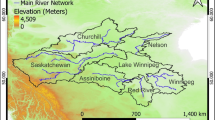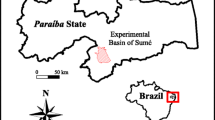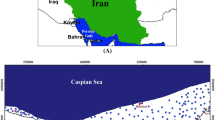Abstract
The Lancang-Mekong River is a trans-boundary river which provides a livelihood for over 60 million people in Southeast Asia. Its environmental security is vital to both local and regional inhabitants. Efforts have been undertaken to identify controlling factors of the distribution of trace metals in sediments and soils of the Manwan Reservoir catchment in the Lancang-Mekong River basin. The physicochemical attributes of 63 spatially distributed soil and sediment samples, along with land-use, flooding, topographic, and location characteristics, were analyzed using the Self-Organizing Map (SOM) methodology. The SOM permits the analysis of complex multivariate datasets and gives a visual interpretation that is generally not easy to obtain using traditional statistical methods. Across the catchment, enrichments of trace metals are rare overall, despite the severely enriched cadmium (Cd). The analysis of SOM showed that flooded levels and land-use types were associated with high concentrations of Cd. Sediments and inundated soils covered with shrub and open woodlands in downstream always have a high concentration of Cd. The results demonstrate that SOM is a useful tool that can aid in the interpretation of complex datasets and help identify the environment of enriched metals on a catchment scale.








Similar content being viewed by others
References
Arias R, Barona A, Ibarra-Berastegi G, Aranguiz I, Elías A (2008) Assessment of metal contamination in dredged sediments using fractionation and Self-Organizing Maps. J Hazard Mater 151:78–85
Bai JH, Cui BS, Xu XF, Ding QY, Gao HF (2009) Heavy metal contamination in riverine soils upstream and downstream of a hydroelectric dam on the Lancang River, China. Environ Eng Sci 26:941–946
Beale MH, Hagan MT, Demuth HB (2014) Neural network toolbox user’s guide (R2014b). The Mathworks, Inc., Natick
Bednářová Z, Komprdová K, Kalábová T, Sáňka M (2015) Impact of floods and their frequency on content and distribution of risk elements in alluvial soils. Water Air Soil Pollut 226:1–12
Cebula E, Ciba J (2005) Effects of flooding in southern Poland on heavy metal concentrations in soils. Soil Use Manag 21:348–351
Chen HZ, Wang JG, Chen JM, Lin H, Lin C (2016) Assessment of heavy metal contamination in the surface sediments: a reexamination into the offshore environment in China. Mar Pollut Bull 113:132–140
Chester R, Stoner JH (1973) Pb in particulates from the lower atmosphere of the Eastern Atlantic. Nature 245:27–28
Chon T-S, Park YS, Moon KH, Cha EY (1996) Patternizing communities by using an artificial neural network. Ecol Model 90:69–78
Deljanin I, Antanasijević D, Vuković G, Urošević MA, Tomašević M, Perić-Grujić A, Ristić M (2015) Lead spatio-temporal pattern identification in urban microenvironments using moss bags and the Kohonen self-organizing maps. Atmos Environ 117:180–186
Fang DD (1998) Research on standard of utilizable rock mass at dam foundation of Manwan Hydropower Plant. Yunnan Hydropower Eng 3:23–27 (in Chinese)
He YL, Zhang YP (2004) The climate characteristics and change trends on basins of Lancangjiang Valley in Yunnan Province. J Mt Sci 22:539–548 (in Chinese)
Jiao W, Ouyang W, Hao FH, Lin CY (2015) Anthropogenic impact on diffuse trace metal accumulation in river sediments from agricultural reclamation areas with geochemical and isotopic approaches. Sci Total Environ 536:609–615
Krongchai C, Funsueb S, Jakmunee J, Kittiwachana S (2016) Application of multiple self-organizing maps for classification of soil samples in Thailand according to their geographic origins. J Chemom 31:e2871
Lee B-H, Scholz M (2006) Application of the self-organizing map (SOM) to assess the heavy metal removal performance in experimental constructed wetlands. Water Res 40:3367–3374
Li L, Wang YP (2014) What drives the aerosol distribution in Guangdong—the most developed province in Southern China? Sci Rep 4:5972–5972
Liu SL, Wang C, Yang JJ, Zhao QH (2014) Assessing the heavy metal contamination of soils in the water-level fluctuation zone upstream and downstream of the Manwan Dam, Lancang River. J Soils Sed 14:1147–1157
Löhr SC, Grigorescu M, Hodgkinson JH, Cox ME, Fraser SJ (2010) Iron occurrence in soils and sediments of a coastal catchment : a multivariate approach using self organising maps. Geoderma 156:253–266
Manuel AG, Cristina GPU, Ana A, Berta G, Viguri JR (2008) Assessment of Self-Organizing Map artificial neural networks for the classification of sediment quality. Instrum Meas IEEE Trans 57:34–47
Nanda T, Sahoo B, Chatterjee C (2017) Enhancing the applicability of Kohonen Self-Organizing Map (KSOM) estimator for gap-filling in hydrometeorological time series data. J Hydrol 549:133–147
National Soil Survey Office (1995) Chinese soil genus records. China Agriculture Press, Beijing
Oetken M, Stachel B, Pfenninger M, Oehlmann J (2005) Impact of a flood disaster on sediment toxicity in a major river system—the Elbe flood 2002 as a case study. Environ Pollut 134:87–95
Olkowska E, Kudłak B, Tsakovski S, Ruman M, Simeonov V, Polkowska Z (2014) Assessment of the water quality of Kłodnica River catchment using self-organizing maps. Sci Total Environ 476–477:477–484
Pandey M, Pandey AK, Mishra A, Tripathi BD (2015) Application of chemometric analysis and Self Organizing Map-Artificial Neural Network as source receptor modeling for metal speciation in river sediment. Environ Pollut 204:64–73
Park YS, Chon TS, Kwak IS, Lek S (2004) Hierarchical community classification and assessment of aquatic ecosystems using artificial neural networks. Sci Total Environ 327:105–122
Pereira P, Carvalho S, Pereira F, De PH, Gaspar MB, Pacheco M, Vale C (2012) Environmental quality assessment combining sediment metal levels, biomarkers and macrobenthic communities: application to the Óbidos coastal lagoon (Portugal). Environ Monit Assess 184:7141–7151
Poot A, Gillissen F, Koelmans AA (2007) Effects of flow regime and flooding on heavy metal availability in sediment and soil of a dynamic river system. Environ Pollut 148:779–787
Roggero M (2009) Individual, population and community level effects of subtle anthropogenic contamination in estuarine meiobenthos. Environ Pollut 157:2751–2758
Santos-Echeandia J, Vale C, Caetano M, Pereira P, Prego R (2010) Effect of tidal flooding on metal distribution in pore waters of marsh sediments and its transport to water column (Tagus estuary, Portugal). Mar Environ Res 70:358–367
Schulz-Zunkel C, Krueger F, Rupp H, Meissner R, Gruber B, Gerisch M, Bork HR (2013) Spatial and seasonal distribution of trace metals in floodplain soils. A case study with the Middle Elbe River, Germany. Geoderma 211:128–137
Speelmans M, Vanthuyne DRJ, Lock K, Hendrickx F, Du LG, Tack FMG, Janssen CR (2007) Influence of flooding, salinity and inundation time on the bioavailability of metals in wetlands. Sci Total Environ 380:144–153
Stachel B, Christoph EH, Gotz R, Herrmann T, Kruger F, Kuhn T, Lay J, Loffler J, Papke O, Reincke H, Schroter-Kermani C, Schwartz R, Steeg E, Stehr D, Uhlig S, Umlauf G (2006) Contamination of the alluvial plain, feeding-stuffs and foodstuffs with polychlorinated dibenzo-p-dioxins, polychlorinated dibenzofurans (PCDD/Fs), dioxin-like polychlorinated biphenyls (DL-PCBs) and mercury from the River Elbe in the light of the flood event in August 2002. Sci Total Environ 364:96–112
State Environmental Protection Administration of China (SEPAC) (2004) The Technical Specification for Soil Environmental Monitoring HJ/T 166-2004. China Environmental Press, Beijing (in Chinese)
Subida MD, Berihuete A, Drake P, Blasco J (2013) Multivariate methods and artificial neural networks in the assessment of the response of infaunal assemblages to sediment metal contamination and organic enrichment. Sci Total Environ 450:289–300
Tang J, Zhong YP, Wang L (2008) Background value of soil heavy metal in the Three Gorges Reservoir District. Chin J Eco-Agric 16:848–852 (in Chinese)
Vesanto J, Alhoniemi E (2000) Clustering of the self-organizing map. IEEE Trans Neural Netw 11:586–600
Veses O, Mosteo R, Ormad MP, Ovelleiro JL (2014) Freshwater sediment quality in Spain. Environ Earth Sci 72:2917–2929
Wang P, Wang JI (2002) Basic climatic characteristics in the Manwan hydropower station reservoir area of Lancang River, Yunnan Province, China. J Yunnan Norm Univ 22:57–61 (in Chinese)
Wang C, Liu SL, Zhao QH, Deng L, Dong SK (2012) Spatial variation and contamination assessment of heavy metals in sediments in the Manwan Reservoir, Lancang River. Ecotoxicol Environ Saf 82:32–39
You Z, Yang YZ, Jiang LG, Feng ZM, Zhang JH (2012) The study on the relief degree of land surface in the Lancang-Mekong River Basin. J Yunnan Univ 34:393–400 (in Chinese)
Zhao QH, Liu SL, Deng L, Yang ZF, Dong SK, Wang C, Zhang ZL (2011) Spatio-temporal variation of heavy metals in fresh water after dam construction: a case study of the Manwan Reservoir, Lancang River. Environ Monit Assess 184:4253–4266
Zhao QH, Liu SL, Deng L, Dong SK, Wang C (2013) Longitudinal distribution of heavy metals in sediments of a canyon reservoir in Southwest China due to dam construction. Environ Monit Assess 185:6101–6110
Acknowledgments
This research was funded by the National Key Research and Development Project (Grant No. 2016YFC0502103) and the National Natural Sciences Foundation of China (Grant Nos. 41571173 and 41530635).
Author information
Authors and Affiliations
Corresponding author
Additional information
Responsible editor: Philippe Garrigues
Rights and permissions
About this article
Cite this article
Cheng, F., Liu, S., Yin, Y. et al. Identifying trace metal distribution and occurrence in sediments, inundated soils, and non-flooded soils of a reservoir catchment using Self-Organizing Maps, an artificial neural network method. Environ Sci Pollut Res 24, 19992–20004 (2017). https://doi.org/10.1007/s11356-017-9559-3
Received:
Accepted:
Published:
Issue Date:
DOI: https://doi.org/10.1007/s11356-017-9559-3




